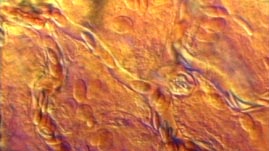The rhythmic and incessant beating of the heart is critical to human
life. Your heart beats on average about 100,000 times a day and will
pump about 42 million gallons of blood during your lifetime.
The heart's main purpose is to pump blood throughout the body to supply
cells and tissues with the food and oxygen they need to survive. The body
contains approximately six quarts of blood. By completely circulating
all six quarts through the body every one to three minutes, the heart
keeps the living system -- our body -- running.
As the
video describes, oxygen-poor blood is taken into the heart and pumped
to the lungs where it picks up oxygen. It then travels back to the
heart before being pumped to cells throughout the body. Along the way,
blood also passes through the abdomen, past cells of the intestines
and the stomach, where it picks up nutrients that it can distribute to
nourish other parts of the body.
How exactly does blood in
the capillaries exchange oxygen, other gases, and nutrients with nearby
cells? In most cases it happens automatically. Differences in pressure
and/or concentration are key to these critical exchanges.
For example, the oxygen-rich blood travelling through a capillary
is under a slightly greater pressure than the cells adjacent to the
capillary. Gases like oxygen move from areas of higher pressure to areas
of lower pressure. And even though the pressure difference between the
capillaries and the cells is slight, it is enough to cause oxygen to
move freely from the blood to the surrounding cells.
Further
along, when the blood begins its journey back to the heart and enters
the slightly larger-diameter veins, its pressure drops to a point that
is lower than the pressure in the adjacent cells. This allows gases like
carbon dioxide -- a waste product -- to move out of the cells and into
the blood stream, where it can be carried to the lungs and released.

 Loading Standards
Loading Standards Teachers' Domain is proud to be a Pathways portal to the National Science Digital Library.
Teachers' Domain is proud to be a Pathways portal to the National Science Digital Library.
